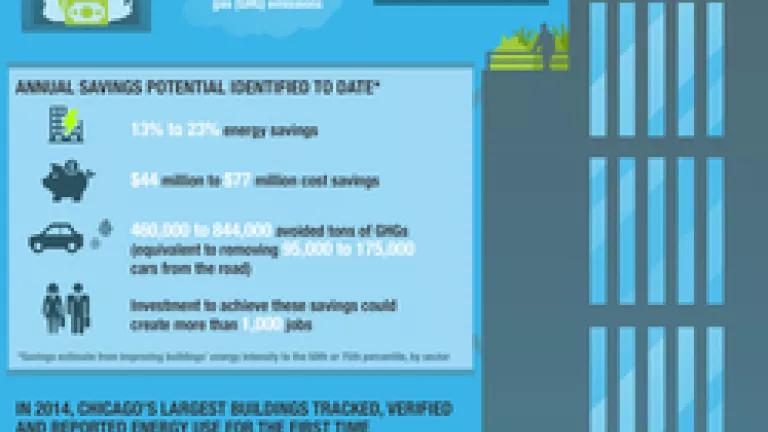
The City of Chicago released its first-ever benchmarking report, which shows promising performance of the city's largest commercial and municipal buildings while identifying further potential for energy efficiency improvement. In short, the report reveals that Chicago's buildings have the potential to reduce their energy use up to 23 percent, saving up to $77 million annually and crea
The report is the result of the first year of compliance with Chicago's Building Energy Use Benchmarking Ordinance, which required nonresidential buildings over 250,000 square feet to measure, verify, and report their energy use to the city by June 1, 2014. NRDC played a key role in gathering and coordinating over 85 companies and organizations, including many leaders in real estate, to support this piece of legislation, which passed in September 2013. And many of those supporters such as USGBC-Illinois and Elevate Energy were crucial to educating and training building owners and property managers on how to comply with the ordinance. Through this partnership with the City, the compliance rate was over 90 percent.
In the upcoming year, commercial buildings 50,000 square feet and over will be required to comply, as well as large multifamily buildings over 250,000 square feet. And in June 2015 the City is authorized to disclose individual building energy data for those buildings that reported this year.
Chicago's participation in the City Energy Project has been an important factor in the development of the first year report. The City Energy Project is a joint initiative of NRDC and the Institute for Market Transformation that aims to improve the energy efficiency of buildings in cities.
The data collected in the report offers an unprecedented amount of information about how Chicago's largest nonresidential buildings are using energy. The report is based 348 buildings representing 260 million square feet of space and approximately 11 percent of citywide energy use in buildings. Overall, the buildings required to report in 2014 had a median ENERGY STAR score above national averages and consistent with the building stock in other cities such as New York City and Washington, D.C.
Buildings are responsible for 71 percent of Chicago's greenhouse gas emissions, but much of the energy used in buildings is wasted. The first year report showed that reducing energy intensity (the energy use per square foot) of reporting buildings could reduce the buildings' energy use up to 23 percent and these reductions in energy intensity could reap between $44 million and $77 million in energy cost savings. The investments needed to reach these reductions could also create more than 1,000 jobs to implement the energy efficiency upgrades in the buildings. The opportunities abound in Chicago for energy efficiency, and it's up to all of us to ensure they are all seized.
